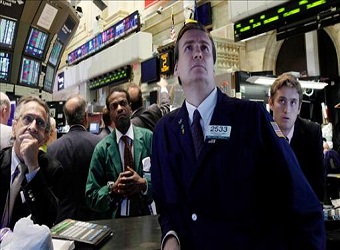U.S. stocks closed mostly flat on Friday, with financials falling around 1 percent, as investors braced themselves for a key constitutional referendum in Italy while digesting a stronger-than-expected jobs report.
The Dow Jones industrial average fell about 20 points in choppy trade, with Caterpillar and Goldman Sachs contributing the most losses. The S&P 500 ended around the flatline, with financials leading decliners. The Nasdaq composite also closed around breakeven.
The Italian referendum is scheduled for Sunday. With this plebiscite, Italian Prime Minister Matteo Renzi wants to change the constitution so that the executive branch needs approval only from parliament’s lower house in order to pass laws. Renzi thinks this change is so important to turn around Italy’s lackluster economy that he has vowed to resign if the referendum is defeated.
“What we’re seeing here is a cautious market because of the Italian referendum,” said Peter Cardillo, chief market economist at First Standard Financial. “If Renzi resigns, that could bring political uncertainty, … and that could bring an attack on the euro.”
The European common currency traded flat against the dollar, near $1.066. The greenback, meanwhile, traded about 0.3 percent lower against a basket of currencies, near 100.7.
“If you look at the bond yields for the Italian bond yields, you can see that they have been rising for some time and the spread between the German and Italian bonds has also raised many eyebrows. The main concern is that if the current prime minister loses the referendum, he will have to resign (he has promised this) and the five star party (anti-euro movement) could create more political instability,” said Naeem Aslam, chief market analyst at Think Markets, in a note.
European equities were under pressure on Friday, with the pan-European Stoxx 600 index falling 0.44 percent and the German Dax sliding 0.2 percent.
In economic news, the U.S. economy added 178,000 jobs last month, the Labor Department said, with the unemployment rate falling to 4.6 percent. Economists polled by Reuters expected a gain of 175,000 with the unemployment rate holding steady at 4.9 percent. Wages, however, slumped to 2.5 percent.
“This relatively strong number may also increase expectations of the pace of rate hikes next year. Market reaction to this morning’s labor report was muted which shows investors had already priced in the increase in payrolls and drop in the unemployment rate,” said Chris Gaffney, president of world markets at EverBank.
Most market participants are expecting the Federal Reserve to raise interest rates on Dec. 14. According to the CME Group’s FedWatch tool, market expectations for a December rate hike were above 90 percent.
Phil Orlando, chief equity strategist at Federated Investors, said that, while Friday’s jobs data will not deter the central bank from raising rates, it was not a good report. “While the consensus was around 180,000 we had expected a number [above 200,000],” he said, noting the ADP report released Wednesday showed gains of more than 200,000 while weekly jobless claims remained around their lowest levels since the 1970s. He also said “the reason why the unemployment rate was so low is a bad one,” citing a jump in discouraged workers.
The S&P and Nasdaq snapped a three-week winning streak as a massive post-election rally slowed down. The small cap Russell 2000, which has outperformed the large indexes, also notched negative week. The Dow, however, recored slight weekly gains.
“This week has been the realization of a few things. Post election, we’ve had euphoria about fiscal spending and deregulation. This week, however, we’ve seen the other side of [the Trump administration] that may not be economically positive,” said Art Hogan, chief market strategist at Wunderlich Securities.
U.S. Treasurys traded slightly higher on Friday, with the benchmark 10-year yield around 2.39 percent and the two-year note yield near 1.12 percent. That said, U.S. Treasurys have fallen sharply since the election, as expectations for fiscal stimulus has weighed.
“Fiscal stimulus is fine, but it is more aligned with a short-term pop in rates,” said Jason Celente, senior portfolio manager at Insight Investment’s Fixed Income Group. “But, without reforms, can yields go much higher? Probably not.”
In oil markets, U.S. crude for January delivery gained 1.2 percent to settle at $51.68 per barrel after the White House said President Obama is expected to sign legislation that would extend sanctions against Iran for 10 years. Elsewhere, Baker Hughes data showed U.S. drillers added three more rigs this week.
The Dow Jones industrial average closed 21.51 points lower, or 0.11 percent, at 19,170.42, with Goldman Sachs leading decliners and Intel the top advancer.
The S&P 500 rose less than a point, or 0.04 percent, to close at 2,191.95, with financials leading four sectors lower and real estate the biggest riser.
The Nasdaq composite advanced 4.55 points, or 0.09 percent, to end at 5,255.65.
About four stocks advanced for every three decliners at the New York Stock Exchange, with an exchange volume of 892.66 million and a composite volume of 3.717 billion at the close.
The CBOE Volatility Index (VIX), widely considered the best gauge of fear in the market, traded lower, near 14.1.
High-frequency trading accounted for 52 percent of December’s daily trading volume of about 9.28 billion shares, according to TABB Group. During the peak levels of high-frequency trading in 2009, about 61 percent of 9.8 billion of average daily shares traded were executed by high-frequency traders.
Source: CNBC
